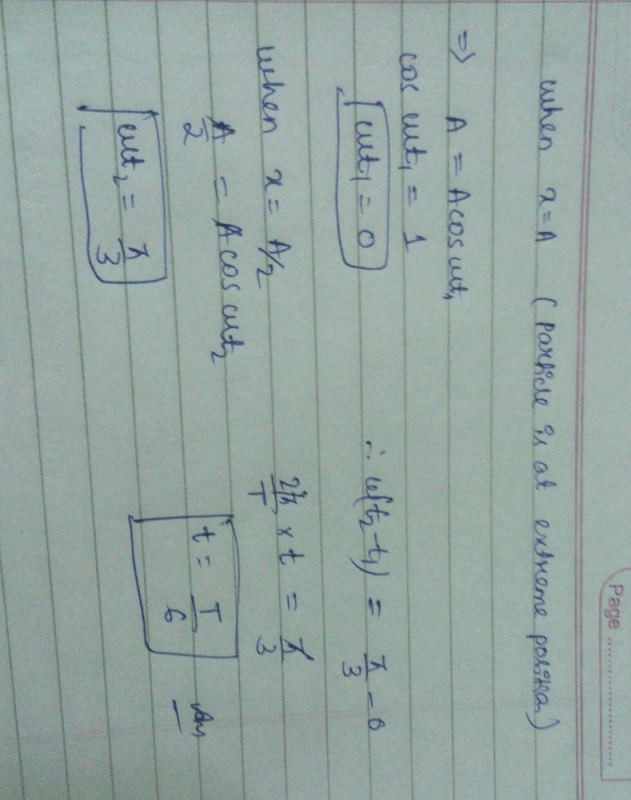NEET Exam > NEET Questions > A simple harmonic motion has an amplitude A a...
Start Learning for Free
A simple harmonic motion has an amplitude A and time period T. Time required to travel from x=A to x=A/2 is: (1) T/6 (2) T/4 (3) T/3 (4) T/4?
Most Upvoted Answer
A simple harmonic motion has an amplitude A and time period T. Time re...
Explanation of Time Required to Travel from x=A to x=A/2 in Simple Harmonic Motion
Definition of Simple Harmonic Motion
Simple harmonic motion is a type of periodic motion where the restoring force is directly proportional to the displacement and is always directed towards the mean position.
Formula for Time Period of Simple Harmonic Motion
The time period of simple harmonic motion is given by the formula:
T = 2π√(m/k)
where T is the time period, m is the mass of the object undergoing simple harmonic motion and k is the spring constant.
Formula for Amplitude of Simple Harmonic Motion
The amplitude of simple harmonic motion is the maximum displacement of the object from its mean position. It is denoted by A.
Formula for Displacement of Simple Harmonic Motion
The displacement of an object undergoing simple harmonic motion can be represented by the formula:
x = A cos(2πt/T)
where x is the displacement at time t, A is the amplitude and T is the time period.
Calculation of Time Required to Travel from x=A to x=A/2
To calculate the time required to travel from x=A to x=A/2, we need to find the time taken for the displacement to change from A to A/2. We can do this by equating the displacement equation to A/2 and solving for t:
A/2 = A cos(2πt/T)
cos(2πt/T) = 1/2
2πt/T = π/3
t = T/6
Answer
Therefore, the time required to travel from x=A to x=A/2 in simple harmonic motion is T/6.
Community Answer
A simple harmonic motion has an amplitude A and time period T. Time re...

Attention NEET Students!
To make sure you are not studying endlessly, EduRev has designed NEET study material, with Structured Courses, Videos, & Test Series. Plus get personalized analysis, doubt solving and improvement plans to achieve a great score in NEET.

|
Explore Courses for NEET exam
|

|
Similar NEET Doubts
A simple harmonic motion has an amplitude A and time period T. Time required to travel from x=A to x=A/2 is: (1) T/6 (2) T/4 (3) T/3 (4) T/4?
Question Description
A simple harmonic motion has an amplitude A and time period T. Time required to travel from x=A to x=A/2 is: (1) T/6 (2) T/4 (3) T/3 (4) T/4? for NEET 2024 is part of NEET preparation. The Question and answers have been prepared according to the NEET exam syllabus. Information about A simple harmonic motion has an amplitude A and time period T. Time required to travel from x=A to x=A/2 is: (1) T/6 (2) T/4 (3) T/3 (4) T/4? covers all topics & solutions for NEET 2024 Exam. Find important definitions, questions, meanings, examples, exercises and tests below for A simple harmonic motion has an amplitude A and time period T. Time required to travel from x=A to x=A/2 is: (1) T/6 (2) T/4 (3) T/3 (4) T/4?.
A simple harmonic motion has an amplitude A and time period T. Time required to travel from x=A to x=A/2 is: (1) T/6 (2) T/4 (3) T/3 (4) T/4? for NEET 2024 is part of NEET preparation. The Question and answers have been prepared according to the NEET exam syllabus. Information about A simple harmonic motion has an amplitude A and time period T. Time required to travel from x=A to x=A/2 is: (1) T/6 (2) T/4 (3) T/3 (4) T/4? covers all topics & solutions for NEET 2024 Exam. Find important definitions, questions, meanings, examples, exercises and tests below for A simple harmonic motion has an amplitude A and time period T. Time required to travel from x=A to x=A/2 is: (1) T/6 (2) T/4 (3) T/3 (4) T/4?.
Solutions for A simple harmonic motion has an amplitude A and time period T. Time required to travel from x=A to x=A/2 is: (1) T/6 (2) T/4 (3) T/3 (4) T/4? in English & in Hindi are available as part of our courses for NEET.
Download more important topics, notes, lectures and mock test series for NEET Exam by signing up for free.
Here you can find the meaning of A simple harmonic motion has an amplitude A and time period T. Time required to travel from x=A to x=A/2 is: (1) T/6 (2) T/4 (3) T/3 (4) T/4? defined & explained in the simplest way possible. Besides giving the explanation of
A simple harmonic motion has an amplitude A and time period T. Time required to travel from x=A to x=A/2 is: (1) T/6 (2) T/4 (3) T/3 (4) T/4?, a detailed solution for A simple harmonic motion has an amplitude A and time period T. Time required to travel from x=A to x=A/2 is: (1) T/6 (2) T/4 (3) T/3 (4) T/4? has been provided alongside types of A simple harmonic motion has an amplitude A and time period T. Time required to travel from x=A to x=A/2 is: (1) T/6 (2) T/4 (3) T/3 (4) T/4? theory, EduRev gives you an
ample number of questions to practice A simple harmonic motion has an amplitude A and time period T. Time required to travel from x=A to x=A/2 is: (1) T/6 (2) T/4 (3) T/3 (4) T/4? tests, examples and also practice NEET tests.

|
Explore Courses for NEET exam
|

|
Suggested Free Tests
Signup for Free!
Signup to see your scores go up within 7 days! Learn & Practice with 1000+ FREE Notes, Videos & Tests.

























